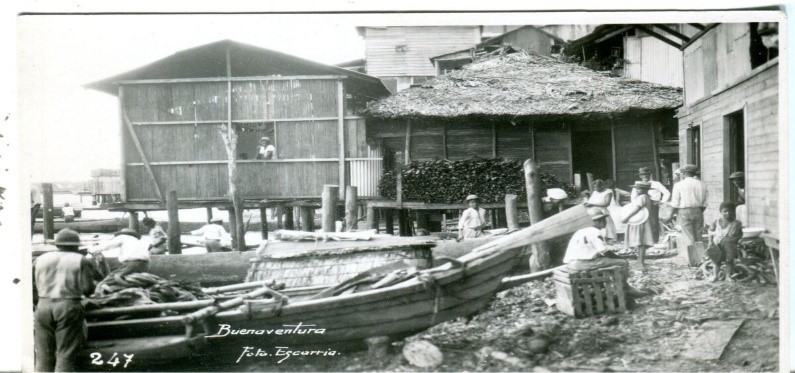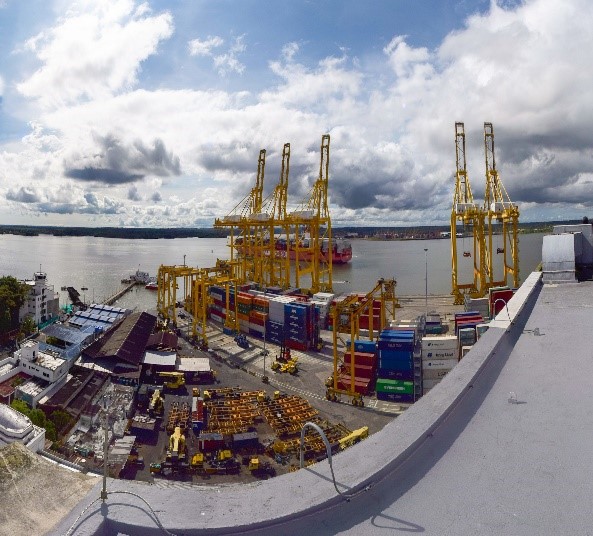Buenaventura
Department
Valle del Cauca, Colombia

Flag of the city
The flag of Buenaventura, Colombia, showcases two diagonally divided triangles of equal size, each bearing a distinct color. The split runs from the upper left to the lower right corner.
The bottom-left triangle is colored yellow, symbolic of the region’s mineral riches, particularly the gold deposits. Buenaventura is mineral-rich, boasting substantial deposits of gold, platinum, coal, and even significant oil reserves.
The upper-right triangle is painted a grass green, representing Buenaventura’s bounty from both the sea and its mountainous terrain. This hue signifies the fertile land of Buenaventura, suitable for the cultivation of crops such as African palm, balata, tagua, and rubber.
The green segment also references the Port of Buenaventura, Colombia’s premier seaport on the Pacific coast, renowned for having the most advanced port infrastructure in the country. This port serves as a primary channel for the nation’s import and export activities.
In formal occasions, the flag of Buenaventura often carries the phrase: “Our Wealth Comes from
The Sea.” This slogan deeply resonates with the locals, acknowledging nature’s bounty and portraying Buenaventura as a blessed land.

Seal of the city

Slogan of the city
Buenaventura is often known as “El Puerto” by many Colombians due to its prominence as the main port on the Pacific coast.
History

Buenaventura, nestled on Colombia’s Pacific coast, boasts a rich tapestry of history and cultural evolution. Established on July 14, 1540, by the Spanish explorer Juan de Ladrilleros, the city’s foundation was a directive from Pascual de Andagoya. Originally, the region was home to the indigenous Buscajas people. However, by the end of the 16th century, indigenous resistance led to the city’s temporary obliteration.
The resilience of its inhabitants shone through as Buenaventura rose from its ashes and was reconstructed. A significant turning point in its trajectory was the inauguration of the Panama Canal in 1914, which elevated the city’s stature in trade and commerce. By the 1950s, its appeal transcended commerce; it became a rendezvous point for the international elite, attracting the ‘international jet set’ for leisure and recreation.
In contemporary times, Buenaventura has anchored itself as a pivotal hub for the distribution of raw materials to surrounding regions. This role has not only enriched its economic landscape but also paved the way for modern developments and infrastructural expansion.
Geography of the city
Buenaventura lies just a short distance from the western ridges of the Andes Mountains and is approximately 116 kilometres (72.1 mi) by road from Cali, the capital of its department. Recognized as one of the world’s wettest cities, it receives an impressive annual rainfall of between 6,000 to 7,000 millimetres (240 to 280 in). Buenaventura, perched on the Pacific coast of Colombia, is geographically positioned at a latitude of 3.8770° N and a longitude of 77.0266°W with Altitude 7 meters (23 feet) above sea level.
Buenaventura is a prominent gateway to the expansive Pacific Ocean and is the leading port of the Valle del Cauca department. Its geography is a tapestry of contrasts, with coastal plains on the west and the undulating foothills of the western Andes on the east. Beyond its oceanic front, the city is interspersed with various rivers, notably the Dagua River, which contributes to the region’s verdant mangroves and wetlands. Dominated by a tropical rainforest climate, Buenaventura experiences consistent warmth, substantial rainfall, and elevated humidity levels. The rains, particularly during the peak seasons, sometimes lead to localized flooding. Off its coast lie intriguing islands, including the ecologically significant Isla Palma, a draw for both nature enthusiasts and tourists. This blend of coastal and hilly terrains not only underscores Buenaventura’s trade significance but also showcases its abundant natural beauty.

Population
475,000(2023)
468,000(2022)
In recent years, the metro area population of Buenaventura has been on a steady rise. In 2019, the population stood at 451,000, and it experienced a 1.81% growth to reach 460,000 in 2020. This upward trend continued into 2021, with the population growing by 2% to 460,000. By 2022, the number further increased to 468,000, marking a 1.74% growth from the previous year. As of 2023, Buenaventura’s metro area boasts a population of 475,000, reflecting a 1.5% increase from 2022.
One photo representative of the city
Because of its position as Colombia’s greatest port, Buenaventura’s port frequently serves as a symbol of the city. Buenaventura’s port serves as an artistic and historical emblem for the city and also a vital economic and transport hub for the entire nation.
Located where the Dagua River flows into the Buenaventura Bay, the Port of Buenaventura stands as Colombia’s primary port on the Pacific coast. Traditionally, this port managed modest coal export volumes. However, there has been growing interest from China in enhancing the port’s capabilities. This interest is tied to a prospective US$7.6 billion initiative to connect Colombia’s coal-rich inner regions to Buenaventura via a new railway, aiming to boost Colombian coal exports across the Pacific. In 2007, the port processed approximately 2.9 million tons of cargo, of which 519,000 metric tons were coal. While total cargo figures surged past 4 million tons in 2014, coal exports plummeted to 99,788 tons by 2015. The Port of Buenaventura, when compared to the adjacent Port of Aguadulce that commenced operations in 2017, has a notably lesser coal storage and loading capacity.
By 2011, discussions emerged regarding a potential railway linking Colombia’s Caribbean and Pacific coasts. This Chinese-proposed railway would serve as an alternative to the Panama Canal, enabling the vast transportation of coal from Colombia’s coalfields to its western coastline for Pacific export, especially to China. An ambitious version of this plan envisions a 791km rail line alongside the enhancement of Buenaventura’s port facilities to handle up to 40 million tons annually.
Domingo Chinea, the port’s general manager in 2011, expressed skepticism about the project’s viability. He highlighted that the port is equipped to handle only ships with a 40,000-ton capacity, much smaller than typical coal carriers. Concerns about the project’s environmental footprint, potential rebel attacks, and the challenges of building through the swampy Darien Gap have also been raised.
Despite these concerns, there were intermittent signs that the Chinese-backed railway initiative might proceed. Statements in 2013 and 2014 by Colombian officials and China’s ambassador indicated potential advancements in the plan. As of 2017, China expressed ongoing interest in expanding the Port of Buenaventura. Throughout 2020, discussions about the port’s expansion persisted, even in the face of environmental apprehensions voiced by the predominantly Afro-Colombian neighboring communities. However, in 2021, protests and obstructions impeded access to the port, directly influencing coal transport.


Etymology
The name “Buenaventura” is Spanish for “good fortune” or “good luck.” Like many places in the New World, Spanish explorers or settlers often named locations based on their experiences, hopes, or religious sentiments.
What the city is known or famous for
Buenaventura, situated on Colombia’s Pacific coast, is renowned primarily as the nation’s foremost port on the Pacific Ocean. Its paramount role lies in serving as a crucial conduit for Colombia’s international trade, where it manages the import and export of goods transported by sea. The city’s strategic geographical location and thriving port facilities establish it as an indispensable epicentre for maritime commerce. Buenaventura boasts a rich and diverse cultural mosaic, characterized by a populace composed of Afro-Colombian, Indigenous, and mestizo communities. This cultural diversity is vividly expressed through the city’s lively music, dance, culinary traditions, and cultural practices, imparting a distinctive character to the locale.
The encompassing region surrounding Buenaventura is gifted with breath-taking natural beauty, featuring luxuriant tropical landscapes and pristine shorelines. These natural wonders make it an alluring destination for eco-tourism enthusiasts and nature lovers.
Buenaventura has not been exempt from pressing challenges, including pervasive poverty, violence, and social inequality. Sustained efforts have been initiated to confront these issues and enhance the living conditions of its inhabitants. Despite these hurdles, Buenaventura remains an integral and multifaceted city, upholding its crucial role in Colombia’s trade while maintaining a unique cultural and environmental heritage.
